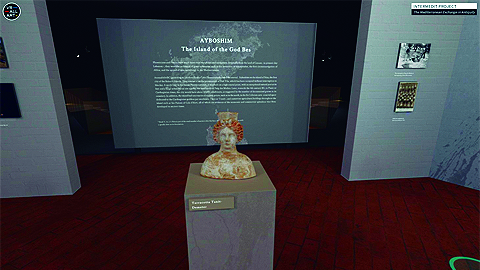The UAB to display Mediterranean archaeological heritage in virtual and immersive exhibition

The CORE in Cultural Heritage network and the OpenLabs conducted a technical performance of the virtual reality exhibition entitled "InterMedit: The Mediterranean Exchange in Antiquity", presented at the Monographic Museum Puig des Molins in Ibiza on 27 April. The exhibition, which offers an immersive experience, includes some 50 pieces digitalised in 3D by the UAB, some of which are on display for the first time, with a maximum of detail, such as the statue of Asclepius of Empúries.
28/04/2023
The exhibition is the result of the "InterMedit Project: The Mediterranean Exchange in Antiquity, a Bridge Between Cultures", a project receiving support from the Pyrenees-Mediterranean Euroregion, with three associated entities: the Association of Friends of the Archaeological Museum of Ibiza and Formentera (MAEF) (Balearic Islands), the Cultural Association of Friends of the Empúries-Unitikesken Museum (Catalonia) and the Oppidum of Enserune Museum (Occitania) through the National Monuments Centre of France. The team also included the participation of museum technicians and the collaboration of the CORE in Cultural Heritage network and the UAB Openlabs of the Universitat Autònoma de Barcelona.
The exhibition demonstrates the origin of a millennial connection of these three Mediterranean regions which form part of the project through their shared archaeological heritage from the time of Antiquity (Phoenician, Etruscan and Greek). Initially conceived as a conventional exhibition, its transfer to a virtual world has made it possible to offer this rich cultural heritage to all publics living in any part of the world.
Users can view the exhibition online on a website developed by the UAB in collaboration with the Swiss company VR-ALL-Art, and immerse themselves in the exhibition using virtual reality glasses. The experience allows users to enjoy a 3D vision of some 50 pieces and sculptures, all digitalised by the UAB at very high resolution and with the maximum of detail. Some of the most representative pieces of the ancient Mediterranean culture on display are the goddess Tanit, from the Puig des Molins necropolis in the city of Ibiza, and the god Esculapi d’Empúries, an icon of Catalan archaeology.
“With this project we demonstrate the ability to create exhibitions which would be practically impossible in the physical world, due to the difficulties in bringing together in one space so many important pieces such as these, which are the maximum representations of eastern sculptures in the pre-Roman Mediterranean. Digitalisation is transforming how we can envision the dissemination of archaeological heritage and museology, and more importantly, it also contributes to democratising culture”, points out Oriol Vicente, archaeologist and head of the CORE in Cultural Heritage network at the UAB. “Moreover, the models we obtained in 3D, many of them never before seen, are also useful for the research and conservation of these pieces” he added.
The project also included the participation of students from the UAB-UPF master's degree in Humanities and Digital Heritage, and student Yuwei Fang had the chance to conduct his master dissertation on the design of a virtual reality environment.
Participating in the presentation of the project were Benjamí Costa, Maria Bofill and Helena Jiménez (MAEF); Jusèp Boya and Marta Santos (Museum of Archaeology of Catalonia); Lionel Izac and Sophie Izac (Centre des Monuments Nationaux, Forteresse de Salses, Enserune), and Oriol Vicente and Igor Bogdanovic (UAB).